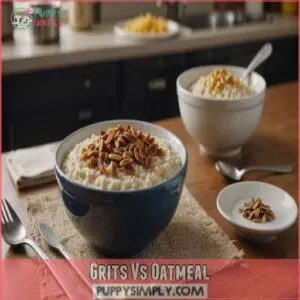This site is supported by our readers. We may earn a commission, at no cost to you, if you purchase through links.

Grits are made mainly from corn, offering carbs but little else for your pup’s nutritional needs.
If your dog doesn’t have a corn allergy, serve grits plain and cooked—skip the butter, sugar, and other toppings.
Just like Grandma’s old recipes, moderation is key to avoid obesity or tummy troubles.
Instant grits? Not the best choice due to low nutritional value.
Instead, think of grits as a rare treat.
Curious about healthier alternatives or tips for feeding grits safely?
There’s a whole world of tasty and safe options to explore!
Table Of Contents
- Key Takeaways
- What Are Grits for Dogs
- Safety of Grits for Dogs
- Nutritional Benefits of Grits for Dogs
- Comparison With Other Foods
- Feeding Grits to Dogs
- Healthy Alternatives to Grits
- Frequently Asked Questions (FAQs)
- Can dogs eat grits?
- Can I Feed my pet bird grits?
- Can dogs eat hominy grits?
- Does Daniel’s Grocery & Bait Shop serve grits?
- Is it okay for a dog to eat grits?
- Why do dogs eat grit?
- What food cannot be given to dogs?
- Is grit safe for dogs?
- How do grits affect a dogs digestion?
- Are there any toxic grits ingredients for dogs?
- Can puppies eat grits safely?
- How do grits impact dogs energy levels?
- Are flavored or seasoned grits safe for dogs?
- Conclusion
Key Takeaways
- Keep grits plain and served in moderation to avoid obesity and stomach issues, as they lack essential nutrients for dogs.
- Watch for corn allergies when feeding grits, and always focus on balanced nutrition with healthier alternatives like lean meats or veggies.
- Avoid flavored or seasoned grits, which can upset your dog’s stomach; stick to plain, cooked grits.
- Remember, grits provide energy through carbohydrates but are not a substitute for protein-rich foods that support your dog’s overall health.
What Are Grits for Dogs
As you ponder whether dogs can eat grits, it’s important to know that grits are a common southern dish made from ground corn and mainly provide carbohydrates.
While your pup might enjoy a small taste, grits have little nutritional value for dogs, so moderation is key.
Ingredients in Grits
Grits are primarily made from corn, providing a carbohydrate-rich base.
They often include butter, milk, salt, and pepper for flavor, although these additions aren’t ideal for your furry friend’s dog diet. Many human foods, such as those listed in the ultimate guide to what chihuahuas can and cant eat, can be toxic to dogs and should be consumed in moderation.
If you’re considering grits as a rare dog treat, make sure they’re plain.
Dogs with a corn allergy should definitely steer clear, prioritizing dog food that supports proper dog nutrition.
Nutritional Value of Grits
Corn-based dishes like grits aren’t loaded with dog-friendly nutrients, and their high carb content can lead to obesity if not balanced with fiber-rich foods that promote healthy digestion and regular bowel movements, as seen in puppy food for digestive health puppy digestive health.
While they do provide some B-complex vitamins and iron, grits lack essential protein and fiber, which are crucial for your pup’s health.
Overindulgence can lead to obesity due to high carbs.
When considering adding grits to your pet’s menu, be sure to choose complex carbohydrates like sweet potatoes or brown rice, as they provide energy and essential nutrients, much like those found in a well-balanced dog food ingredients list, and focus on moderation and balance with other dog food ingredients.
Can Dogs Eat Hominy
So, you’ve learned about the nutritional value of grits. Now, let’s talk hominy. It’s similar to grits, but different.
Can your dog eat it? The short answer is maybe.
Here’s what you need to know:
- Hominy is processed corn.
- It’s lower in fiber than grits.
- Introduce it slowly to avoid stomach upset.
- Always check with your vet before adding new foods.
Is Hominy Good for Dogs
Considering if hominy is beneficial for your dog involves looking at its nutritional value.
While hominy is corn-based, it’s different from grits and can be a treat in moderation.
Just keep an eye out for allergies, especially in puppies.
If your pup struggles with weight gain, limit hominy as it’s high in carbs.
Always consider dog breed and age.
Safety of Grits for Dogs
When considering grits for your dog, it’s important to remember that moderation is key to preventing unwanted weight gain and stomach issues.
While grits can sometimes be safely included in your dog’s diet, always check for any allergic reactions and stick to plain varieties without harmful additives.
Can Dogs Eat Instant Grits
Your furry friend might eye your instant grits, but think twice before sharing.
While safe in tiny amounts, instant grits offer minimal nutritional value for dogs and can lead to weight gain due to their high carbohydrate content.
Always prioritize dog-specific treats or healthier options, like lean meats or veggies, for snack time.
Keep grits as an occasional treat to make sure safety.
Risks of Overfeeding Grits
Feeding Fido too many grits can lead to a dog-sized dilemma.
Obesity and weight gain are just the tip of the iceberg, with risks of diarrhea and unsettling blood sugar spikes also in the mix.
If you’re considering adding grits to your pup’s diet, you can find a variety of grits dog products online at Grits for Dogs.
Overdoing it might leave your pup with nutritional deficiencies, especially in important fat-soluble vitamins.
So, treat grits as an occasional indulgence in your food therapy routine.
Allergic Reactions to Grits
After noticing the risks of overfeeding grits, let’s chat about allergic reactions.
Some dogs might be sensitive to corn, which is a primary ingredient in grits.
Watch for symptoms like itching, vomiting, or diarrhea—classic signs of a corn allergy.
If you see these, consider safe alternatives like oatmeal or lean meats to keep your furry friend happy and healthy.
Nutritional Benefits of Grits for Dogs
You might think your dog will wag with excitement at the prospect of grits for breakfast, but these corn-based treats offer little more than a high dose of carbohydrates and some vitamins and antioxidants.
Just make sure you’re feeding them in moderation to avoid any unexpected runs to the vet!
Vitamins and Minerals in Grits
Beyond the carbs, grits offer some nutritional value for your canine companion.
While not a nutritional powerhouse, they contain several beneficial components.
You can find dog-safe grits products online, such as at Grits Dog Safe.
What’re they?
- B vitamins
- Iron content
- Folate
- Arginine
- Other trace minerals
Remember, moderation is key! Too many grits can upset their tummy. Always check with your vet before adding new foods to your dog’s diet.
Antioxidants in Grits
You may not think of grits as a powerhouse, but those little bowls pack some antioxidant benefits, especially for your pup’s vision.
Zeaxanthin and lutein, found in grits, can boost eye health.
While veggies might edge out grits in a nutrient showdown, a little grits can make your dog’s vision sharper.
It’s like giving them superhero sight!
Carbohydrates in Grits
Grits pack a punch with carbs, sneaking into your dog’s diet a bit too easily.
They could lead to weight gain if not balanced with alternative treats.
While grits can be enjoyed in moderation, don’t let them be the main star.
Mix it up with veggies or lean meats to keep your furry friend healthy and happy without the extra pounds.
Energy From Grits
While corn-based carbs in grits fuel Fido’s zoomies, they lack the muscle-building power of protein.
An energy boost is nice, especially for high-activity pups, but balance is key.
Too many grits could make your pooch a couch potato.
- Grits vs. Protein: More carbs, less muscle power.
- Dog Activity Level: Consider energy needs.
- Grits & Calories: Moderation is essential.
- Carb Content: Balance with protein.
Comparison With Other Foods
When deciding what to feed your dog, it’s important to compare grits with other foods like oatmeal, eggs, and lean meats.
Understanding the nutritional benefits and potential risks of these options can help you make informed choices for your furry friend’s diet.
Grits Vs Oatmeal
Switching gears from vitamins, let’s chew over grits vs. oatmeal for dogs.
Oatmeal wins the health race with more fiber and protein, promoting better digestion.
If you’re interested in exploring dog food grits for sale, you can find various options at dog food grits marketplaces like dog food grits products.
Grits lag behind with little nutritional boost, being more like a treat.
Imagine dog food with stronger “muscles” from oatmeal’s nutrition.
| Feature | Grits | Oatmeal |
|---|---|---|
| Carbs | High | Moderate |
| Protein | Low | Moderate |
| Digestion | Less Effective | More Effective |
Eggs and Grits for Dogs
You’re probably wondering if eggs add something that grits can’t.
Eggs boast protein and essential amino acids, making an egg & grit combo nutritious for your pup.
However, moderation is key.
Eggs as dog treats offer more nutritional value compared to grits alone.
- Egg & grit dangers
- Grits vs. eggs benefits
- Balancing nutrients
- Observing dietary effects
Grits Vs Lean Meats
Let’s compare grits to lean meats.
Lean meats pack a protein punch, very important for your dog’s muscle mass and energy.
Grits, on the other hand, are mostly carbs.
Think of it this way:
| Food | Protein Content | Weight Management |
|---|---|---|
| Lean Meats | High | Helps maintain weight |
| Grits | Low | Can lead to weight gain |
| Oatmeal | Moderate | Good for weight management |
Lean meats are a better choice for a balanced diet and weight management.
Remember, moderation is key with any treat!
Plan your dog’s meals carefully for good health.
Feeding Grits to Dogs
When feeding grits to your furry friend, it’s important to keep portions small to prevent digestive issues.
Cooked grits can be a safe occasional treat, but always make sure they’re plain and free of added ingredients like salt, butter, or sugar.
How Many Grits Are Good for Dogs
When considering how many grits are good for dogs, think small portions.
A tablespoon or two of plain, cooked grits can be a rare treat, especially for larger dogs.
Check your dog’s reaction to make sure they tolerate it well.
Keep grits frequency low and aim for variety in treats to maintain a balanced diet and prevent any overindulgence.
Can Dogs Eat Cooked Grits
Cooked grits can be a safe treat for your dog, but moderation is key.
While they’re low in nutrients, they’re also easy on the tummy, kind of like rice.
Adding certain nutrient-rich foods like cooked fish skin alternatives can help balance out the meal.
Watch for weight gain since grits are carb-heavy, which could lead to obesity.
A simple cooked grits recipe without added fats makes digestion remain smooth and easy.
Tips for Feeding Grits
Feeding your dog grits? Think moderation.
Choose plain, unsweetened grits, cooking them without salt.
A spoonful added to their usual meal keeps it a tasty change, not a main course.
Resist adding butter or milk, as these can upset their tummy.
Grits frequency should be low—just a once-in-a-while treat—ensuring your fur buddy’s diet stays balanced.
Avoiding Overfeeding Grits
Grits might be tasty to your dog, but too many can lead to pudgy pups and unpleasant surprises on the carpet.
Watch those portions to prevent grits-induced weight gain and diarrhea.
Since grits are low in protein, they shouldn’t replace higher-protein treats.
Keep an eye on your dog’s waistline and opt for balanced, dog-friendly alternatives to avoid grits-related obesity.
Healthy Alternatives to Grits
When looking for healthier alternatives to grits for your dog, consider dog-specific treats, cooked vegetables, or fruits, which are nutritious and delicious.
Lean meats can be another excellent option, ensuring your furry friend gets the protein they need without the extra carbohydrates.
Dog-Specific Treats
Since grits aren’t the most nutritious option, you’ll want to explore better alternatives.
Look for dog-specific treats; many offer balanced nutrition and safety.
Consider making your own homemade dog treats rolled oats, which can be a healthier and more personalized option.
Check the ingredients list – you want to avoid artificial stuff.
Homemade treats are fun, but make sure they’re safe for your pup.
Remember, moderation is key with any treat! A little goes a long way in keeping your furry friend happy and healthy.
Cooked Vegetables and Fruits
Ever thought about swapping grits for something fresher?
Dog-safe veggies like carrots and peas are perfect and add a crunch.
Fruits like apples provide many benefits and a sweet kick.
Just remember, veggie prep is key—steamed is best—and keep fruit portions small to avoid sugar spikes.
These safe snacks are healthy and a delight for your pup!
Lean Meats for Dogs
Lean meats like chicken, turkey, or beef are excellent alternatives to grits for your furry friend.
They’re packed with protein, supporting muscle health.
Opt for safe meat choices, ensuring it’s cooked thoroughly and without added seasonings.
Watch meat serving sizes to avoid overfeeding and consult your vet to address any meat allergy concerns specific to your dog’s needs.
Balanced Diet for Dogs
Imagine your pup wagging its tail at the dinner table, hoping for a taste.
You might think about lean meats like fish or chicken.
These provide essential protein sources.
For a balanced diet, explore:
- Regular vet-approved treats, such as fruits and vegetables, also offer nutritional safety, while snacks like high sodium saltine crackers can be detrimental to a dog’s health. Dog food brands offer nutritional safety.
- Homemade dog food lets you control ingredients.
- Commercial dog food meets diverse dietary needs efficiently.
Frequently Asked Questions (FAQs)
Can dogs eat grits?
Yes, dogs can eat grits, but only in moderation.
Grits offer little nutritional value and too much can cause weight gain or diarrhea.
Always consult your vet before adding new foods to your dog’s diet.
Can I Feed my pet bird grits?
Grits aren’t ideal for birds. They lack essential nutrients. Stick to birdseed or commercially prepared food. Your feathered friend will thank you!
Can dogs eat hominy grits?
You can feed your dog hominy grits in moderation, but they’re not particularly nutritious for dogs.
They contain carbohydrates and little protein, which is essential.
Consult your vet for balanced feeding advice to avoid unnecessary health issues.
Does Daniel’s Grocery & Bait Shop serve grits?
Dining out sometimes surprises you, like finding grits at Daniel’s Grocery & Bait Shop.
They might serve them alongside fried fish or southern-style meals.
It’s best to call ahead, ensuring they’re on the menu before visiting.
Is it okay for a dog to eat grits?
Grits are safe for your dog in moderation, but they offer little nutritional value.
It’s best to consult your vet for specific feeding guidelines and alternatives.
They can be overfed easily, leading to obesity and diarrhea.
Why do dogs eat grit?
Back in the olden days, dogs might’ve nibbled on grit simply out of curiosity or hunger pangs, but it’s not ideal.
Grits provide minimal nutritional value and can upset their stomach.
Stick to dog-friendly treats instead.
What food cannot be given to dogs?
You shouldn’t give your dog chocolate, grapes, raisins, onions, garlic, or xylitol.
These foods can be toxic and harm their health.
Always check what your furry friend can safely enjoy before sharing your meal.
Is grit safe for dogs?
Did you know feeding dogs too many carbohydrates can lead to weight gain?
Grits are safe in small amounts but lack protein and offer minimal nutrition.
Talk to your vet to make sure your furry friend has a balanced diet.
How do grits affect a dogs digestion?
Grits‘ high carbohydrate content can cause digestive upset in dogs, potentially leading to diarrhea or weight gain.
They offer minimal nutritional value, so it’s best to offer healthier alternatives.
Moderation is key, always consult your vet.
Are there any toxic grits ingredients for dogs?
Watch out for ingredients like butter and certain milk products in grits, as they can upset a dog’s stomach.
Always steer clear of additional harmful additives.
Consult your vet for personalized advice on safe treats.
Can puppies eat grits safely?
Puppies can occasionally nibble on grits, but it’s not ideal since they provide little nutritional value.
Too many grits can lead to weight gain or upset stomachs.
Always consult your vet for personalized feeding advice.
How do grits impact dogs energy levels?
Feeding grits to dogs can boost their energy because they’re high in carbohydrates.
However, it’s important to limit portions to avoid weight gain and blood sugar spikes.
Stick to moderation, and you’ll keep your pup healthy and active.
Are flavored or seasoned grits safe for dogs?
Imagine your dog savoring a gourmet meal of buttered grits with a hint of garlic—sounds fun, right?
Sadly, seasoned grits can upset their tummies.
Stick to plain grits, and always chat with your vet first.
Conclusion
Consider the occasional bowl of grits like the rain on a sunlit day for your dog—refreshing but not always necessary.
Can dogs eat grits? Yes, in moderation.
Keep them plain and cooked to avoid allergies and tummy troubles.
While grits offer some energy, they lack essential nutrients.
Balance them with more nutritious foods like lean meats and veggies.
A balanced diet that includes nutrient-rich foods like beans and rice options can help create harmony, and a healthy dog diet is like a well-tuned piano, harmonious and varied.
Always prioritize your pup’s health!














